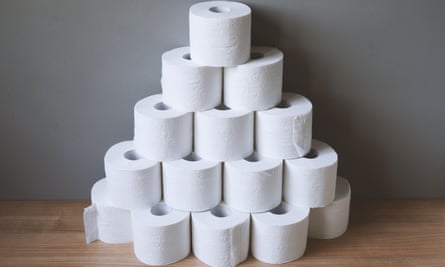Handbags and cars are more traditional status symbols, but in these topsy-turvy times the humble toilet roll is being treated with more reverence than you would expect for something used to wipe your bottom with. In the toilets of trendy restaurants or friends, proud pyramids of loo roll stand in bright, graphic wrapping. On Instagram, influencers now allow it to stay in the backdrop of bathroom selfies rather than hiding it.
While Who Gives A Crap (WGAC) may be one of the more familiar brands, delivering its first striped and spotty rolls in 2013, others with similarly colourful packaging and eco-friendly messaging have sprung up such as Bazoo and Feel Good. There are also those in more muted tones including The Cheeky Panda, Bumboo and Naked Sprout. Using recycled paper or bamboo, they are not shy about advertising their sustainable credentials.
Such symbols of ethical consumption might once have been part of a niche market but they have been gaining traction since the spike in overall toilet roll sales at the start of the pandemic. Simon Griffiths, the chief executive and co-founder of WGAC, says: “In the first few days of March 2020, we peaked at selling 28 rolls per second.”

While some of the brands can still be found online only, others are available at convenience stores and supermarkets across the UK. Feel Good is available at Waitrose and WGAC soon will be. WGAC does the TV advertising stuff but it is also pushing the envelope in other ways: this week it launched a range inspired by “real science”, with pictures of puppies and affirmations designed to help boost happy hormones – because “a better mood means better number twos”.
Demand for eco-rolls is likely to increase because of the impact of EU deforestation laws on the broader toilet paper sector. The majority of toilet paper companies are affected by the legislation, which came into effect in May, because they are heavily reliant on virgin pulp from newly harvested trees as a raw material for their products.
There is another factor, according to Claire Dickinson of the trend forecasting company WGSN. “The trend coincides with the rise of personal expression in interiors,” she said.
Dickinson says consumers are “paying attention to the finer details” right down to their loo paper, adding that design is key. “Graphic patterns on the individually packaged toilet rolls also appeal to those with less storage space as they can be artfully left on display,” she says.
If the overtly branded rolls signify a certain status, so too do the more minimalist brands, whose design is conveying the toilet paper equivalent of “stealth wealth”. Neutral-hued, these rolls assert their provenance only with subtle hints, just as a detail might on a baseball cap by the Row or a Loro Piana suede mule.

Consumers are not lacking for choice in the bathroom. The soap and cosmetics brand Aesop has been selling, at about £20 a bottle, Post-Poo Drops that in effect mask “disagreeable smells with crisp notes of citrus peel and discreet florals”, while silicone loo brushes that are used at a branch of the private members club Soho House are something of a cult item. The traditional British shame around all things scatological seems to have been replaced by a sense of pride in the products that can make using the bathroom a more pleasant experience.
Opting for one of these branded eco-rolls may be a form of conspicuous consumption, but it also allows you to broadcast your green credentials to guests.
Griffiths rejects the idea that the toilet roll is becoming a status symbol, saying people are “opting in for products that are aligned with their values” instead. WGAC donates 50% of its profits to help improve sanitation all over the world.
Fflur Roberts, the head of luxury goods at the market research company Euromonitor, says: “Post-pandemic, consumers increasingly demand that companies support social initiatives and reduce their environmental footprint.” She adds that brands that “not only show commitments through claims but also invest in educating consumers on the various facets of sustainability such as water sanitation” are the ones resonating better with young people.

There may also be something in the appeal of a large pile of rolls, according to Sabrina Faramarzi, a trend analyst. She wonders whether the popularity of the pyramid of rolls has something to do with “this idea of being prepared” after the pandemic shortages.
Faramarzi draws a parallel between the kind of people lucky enough to have a well-stocked pantry and those who are in no danger of running out of toilet roll. These are the “kind of people who have their shit together”, she says. And brands such as Bazoo, Naked Sprout and Bumboo may appeal to that mindset, selling their product in packs no smaller than 24 rolls.
Naked Sprout’s recycled and bamboo ranges are £23.50 for 24 rolls, while Bumboo’s prices for the same number start at £23.
Premium toilet roll is nothing new. Paper was a luxury product in the days when the function was ordinarily performed by sheep’s wool, leaves or even shells, according to Richard Smyth, the author of Bum Fodder: An Absorbing History of Toilet Paper. In medieval Europe, wealthy people would have used soft wool while poorer people used coarser cloth. As Faramarzi puts it: “Class has always been embedded in the history of wiping culture.”
